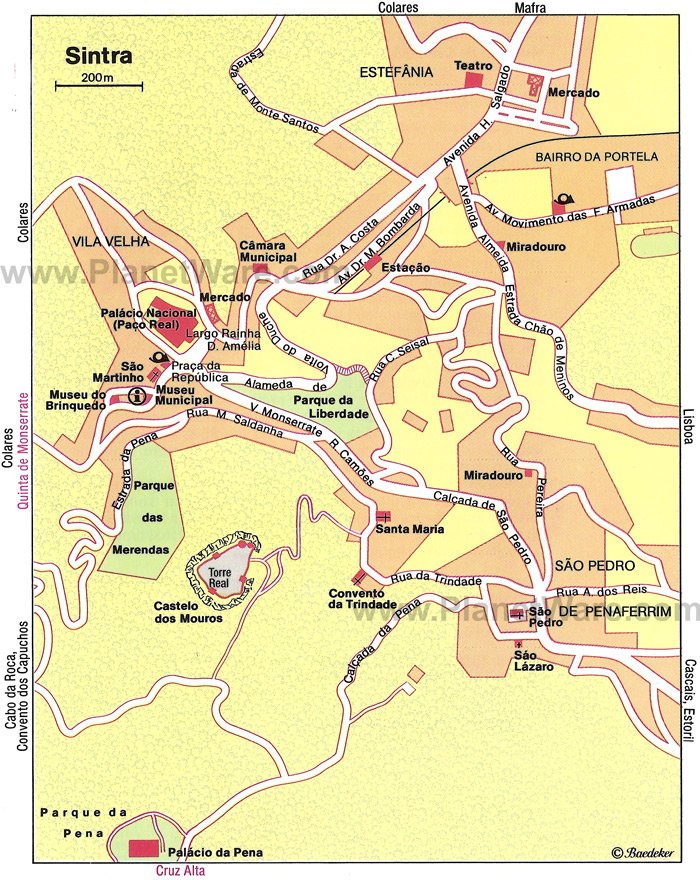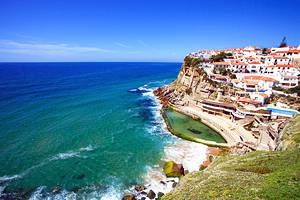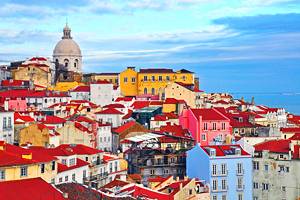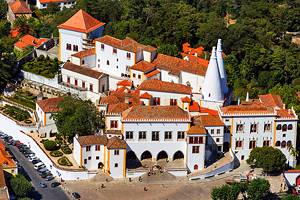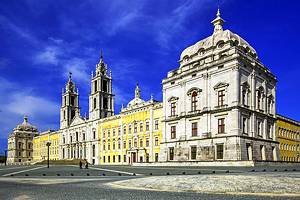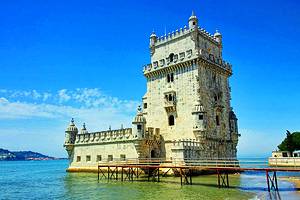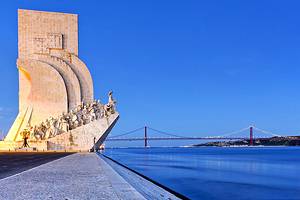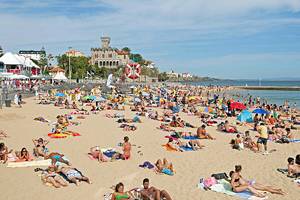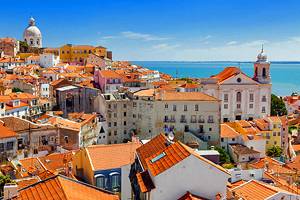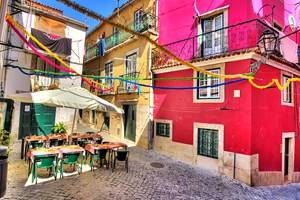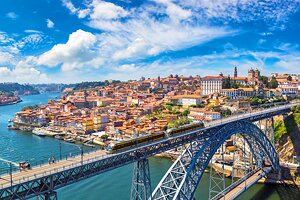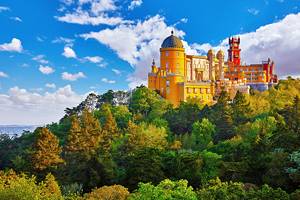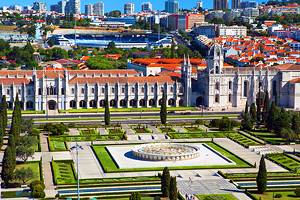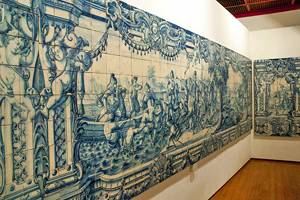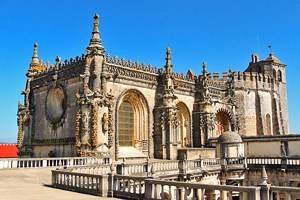Tourist Attractions in Sintra
Lying just 30 kilometers northwest of Lisbon, but a world away from the clamor of city life, Sintra nestles at the foot of the wooded Serra de Sintra, dramatic mountains that define the landscape of this enchanting destination.
The verdant surroundings and cooler air made Sintra a favorite summer sojourn for the Kings of Portugal. It also attracted writers and poets, among them novelist William Beckford and Lord Byron whose epic narrative, Childe Harold's Pilgrimage was partly inspired by his visit to "Cintra." Its romantic allure and stunning collection of parks and palaces led UNESCO to recognize Sintra as a major influence on the development of landscape architecture throughout Europe and honored the region with World Heritage status in 1995.
Sintra's scenic old town, Sintra Vila, is centered on the Palácio Nacional de Sintra. The cobbled square in front of the palace is lined with shops, cafés, and colorful townhouses and is a good place to begin exploring. Those with stout legs will enjoy the climb to the castle; alternatively, sightseers can take a bus, which also stops at Palácio da Pena. A vehicle is the best way to take in other tourist attractions.
For more ideas on the best places to visit, see our list of the top attractions in Sintra.
- Palácio Nacional de Sintra
- Castelo dos Mouros
- Palácio da Pena
- Quinta da Regaleira
- News Museum
- Monserrate
- Convento dos Capuchos
- Palácio de Seteais
- Frequently Asked Questions
- How do you get from Lisbon to Sintra?
- What are the best beaches near Sintra?
- What are the must-see destinations near Sintra?
- Map of Tourist Attractions in Sintra
Palácio Nacional de Sintra
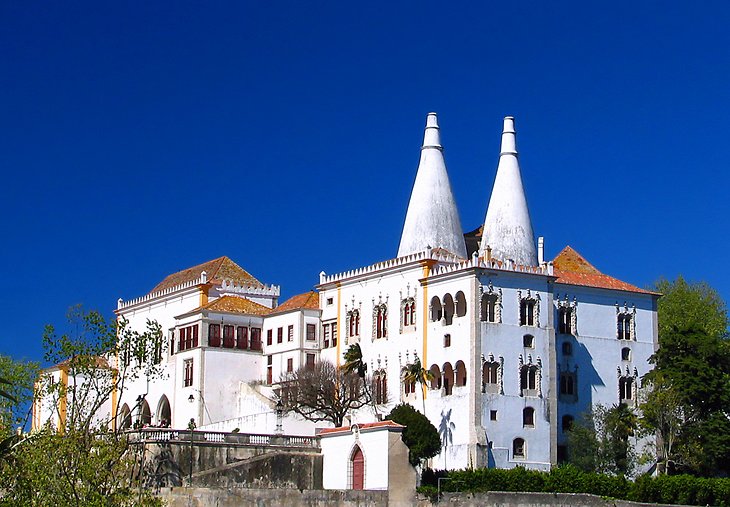
A pair of odd-looking conical chimneys distinguishes the exterior of Sintra's National Palace. Tapering off into the air, their strange form draws the eye towards the center of the old town where this illustrious former royal residence holds court.
Built for King João I in the 14th century, this is the oldest surviving palace in Portugal. Known also as the Paço Real, it is a sumptuous property, and to appreciate it fully deserves a good hour of your time. The building unveils itself over several floors, and the walk-through begins in the majestic Sala dos Cisnes (Hall of Swans), so named for the painted swans decorating the ceiling. Similarly, farther on, the Sala das Pegas (Hall of Magpies) honors this cheeky member of the crow family. See if you can count them all.
The highlight of the upper levels is undoubtedly the astonishing Sala dos Brasões. This glittering hall is banded by superb azulejo tile work, while the domed ceiling is embellished with the coats of arms (brasões) of 72 noble Portuguese families. And what about those chimneys? They can be admired as part of a tapered roof in the palace kitchens, along with a display of polished copper utensils once used to prepare royal banquets.
Castelo dos Mouros
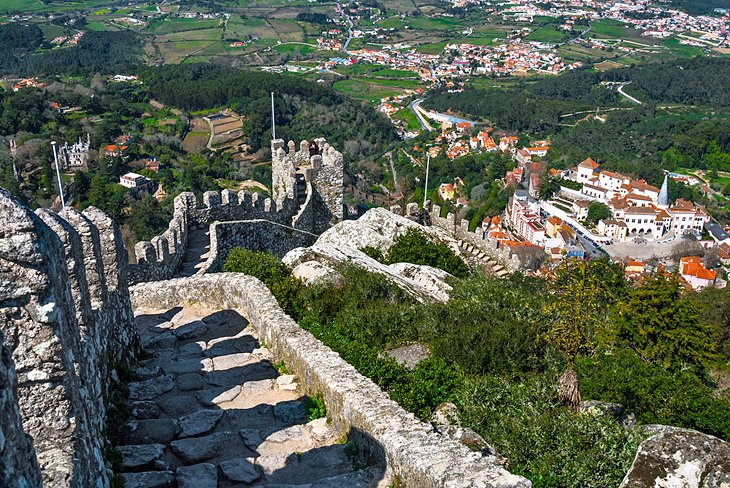
Standing high above the old town across a craggy escarpment, the 8th-century Moorish Castle adds dramatic character to the barren landscape. Its weather-worn ramparts follow the precipitous contours of the Serra and serve as a reminder of how strategically important the stronghold was - it was eventually taken from the Moors in 1147 by King Afonso Henriques.
A way-signed footpath from the church of Santa Maria in town leads walkers up through the steep and wooded lower slopes to the castle's curtain walls. Here, a number of Moorish grain silos stand near the ruins of a medieval Christian church and cemetery. To enter the castle proper, a ticket needs to be purchased from the interpretation center near the road entrance, where buses pull up to disgorge those less inclined to don hiking boots. Within the walls lie an ancient Moorish cistern and the foundations of Muslim dwellings.
The castle's three squat towers, set between chunky battlements, can be climbed and afford breathtaking views of the town below and the Atlantic coast. One of them, "Fernando's Tower" is named after the Portuguese monarch who restored the walls in the 19th century - a genuine King of the Castle.
Address: Estrada da Pena, Sintra
Palácio da Pena
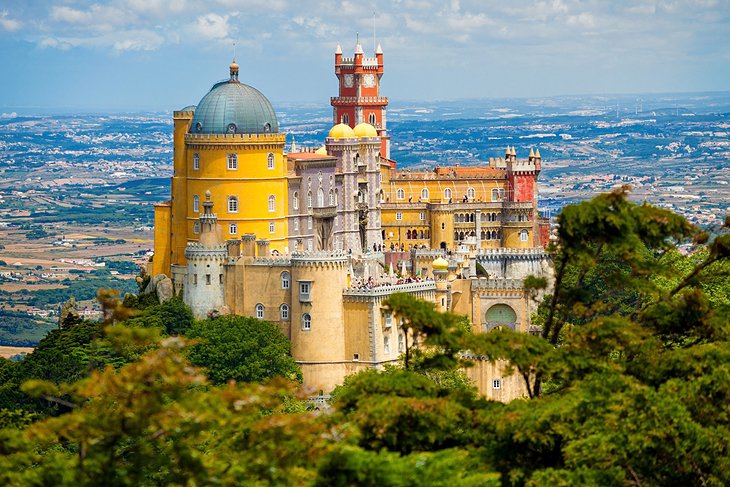
From a distance, the palace of Pena resembles a huge marzipan birthday cake with its pink and lemon facades, crenellated towers, bulbous domes, and spinning top turrets.
This gloriously exaggerated and fanciful creation was built in the 19th-century to satisfy the whim of Ferdinand Saxe-Coburg-Gotha, husband of Queen Maria II. It crowns the highest peak of the Serra de Sintra and its zany profile can be seen from as far away as Lisbon.
Exploring this extraordinary building is like being an extra in a period drama, except the film set is real. The interior is lavishly decorated with curios from around the globe. Highlights include the serene Arab Room, covered wall-to-ceiling with amazing trompe-l'oeil frescoes. The recently refurbished Ballroom positively shimmers, its stained-glass windows casting a rainbow wash across a priceless collection of Chinese porcelain.
Another star draw is the 16th-century chapel and its ornate altarpiece, the only surviving part of the monastery that once occupied the site before the palace was built. Outside, youngsters can indulge in games of hide and seek along the sinewy walls, while adults can marvel at the views across the Sintra hills and the distant Atlantic coastline.
Address: Estrada da Pena, Sintra
Quinta da Regaleira
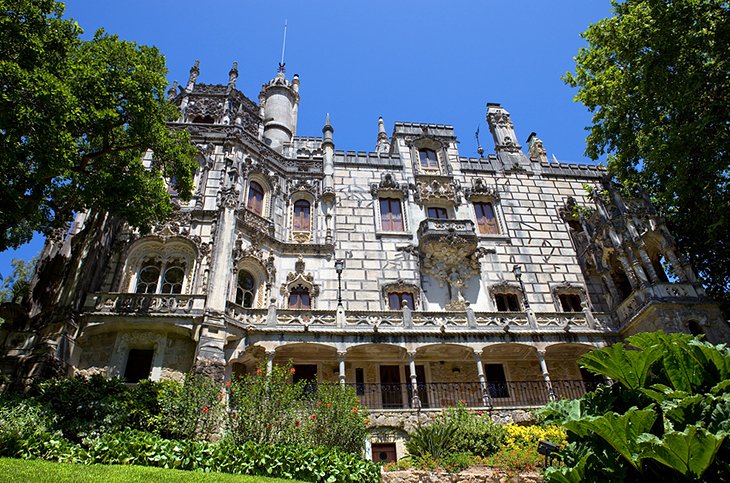
Hollywood ace Johnny Depp filmed part of the supernatural thriller The Ninth Gate within this fantastically landscaped estate. The turreted Palácio dos Milhões appeared spooky enough for several exterior nighttime scenes to be shot around the late 19th-century property, and it's the palace's association with the mystical that attracts sightseers to this offbeat Sintra scene-stealer.
It's no coincidence that the estate was designed by a theatrical set designer, Luigi Manini, who was commissioned by eccentric millionaire António August Carvalho Monteiro to create a retreat woven with religious references and symbols of the occult.
While the palace itself is more about style than substance, the gardens bristle with intrigue. Hidden among the lakes and fountains are secret passages and hidden grottoes, and it's great fun following the false leads and dead ends. But when you do eventually stumble upon it, the Initiation Well is as eerie as it gets. The floor is reached by tiptoeing down a dank, spiral staircase; a long, echoing tunnel leading back up to the surface is the alternative way to exit the subterranean chamber.
Address: Rua Barbosa du Bocage, Sintra
Official site: www.regaleira.pt
News Museum
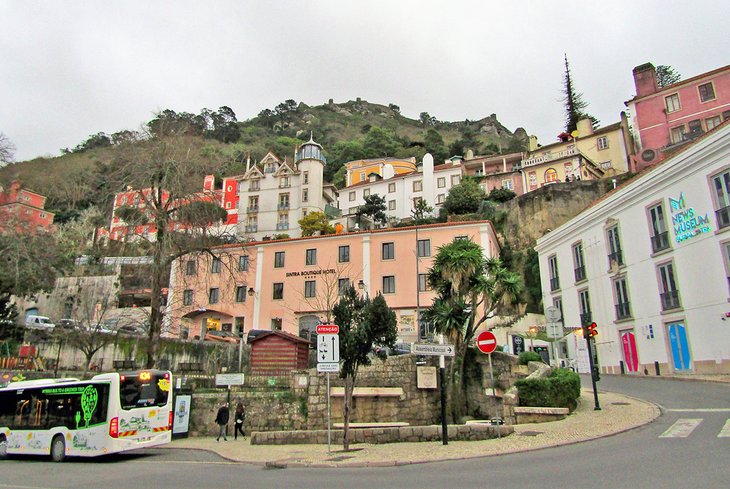
Located in the same building that used to house the Toy Museum, this new permanent exhibition spotlights the role news, media, and communication plays in the modern world, and is fast becoming a highly valued tourist attraction.
Presented in a physical, hands-on manner, as well as conveyed virtually, it allows visitors to interact with radio and television presentations broadcasting media coverage of episodes in recent history. Revisiting the scene affords a re-evaluation of what took place and asks whether the story was told impartially and without bias.
The "fake" news phenomenon is examined in detail. Other themes investigated include the alleged use of propaganda techniques throughout the Public Relations industry. Fascinating and disturbing in equal measure, the exhibition also looks at the role of the combat photographer and includes an eye-opening display of iconic photojournalism featuring images such as the portrait of Che Guevara taken by Alberto Korda - the most reproduced image in the history of photography - and astronaut Buzz Aldrin on the moon, taken by Neil Armstrong.
Incongruous in Sintra's romantic and classical setting perhaps, this very modern and contemporary facility nonetheless raises some interesting questions about exactly what role the media is playing, or is supposed to play, in the 21st century.
Address: Rua Visconde de Monserrate 26, Sintra
Official site: http://www.newsmuseum.pt
Monserrate
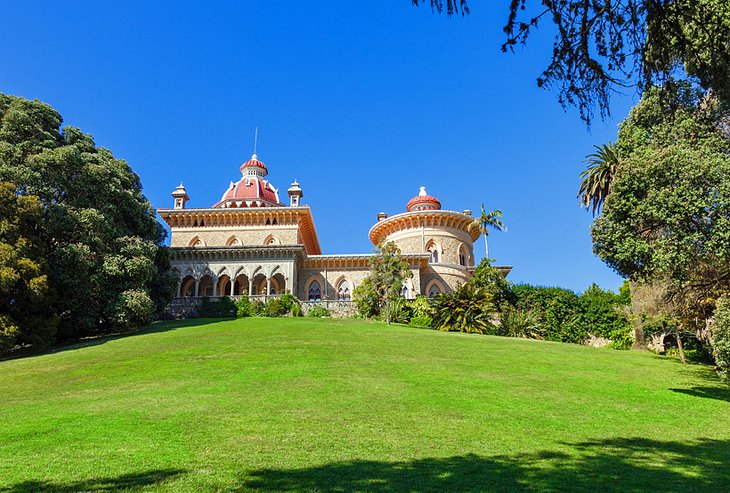
Tucked into the Serra de Sintra hills well away from the historic town center are the romantic gardens of Monserrate. Strolling around here is one of the popular things to do on a sunny day.
This verdant semi-landscaped estate is embroidered with an abundance of sub-tropical foliage and flowering shrubs planted around a valley of emerald green tree fern. Clumps of conifer, swaying palms, and other exotic trees such as the giant Metrosideros (Australian Christmas tree) and the Chinese weeping cypress provide a lush, bountiful canopy that casts dappled sunlight over a small lake and a cascading waterfall. A swathe of flora has been allowed to grow wild and has long since reclaimed the ruins of a chapel half hidden in the undergrowth.
The garden's English-style dimensions are deliberate. Wealthy dandy William Beckford, who penned the Gothic novel Vathek, rented the estate from 1793 to 1799 and added the water features you see today. Later, another Englishman, Sir Francis Cook, imported the strange-sounding trees, added a sweeping lawn, and built the whimsical Moorish-style palace that peers over the green baize grass.
Admission to the palace is included in the estate's entrance fee, and while scant in furnishings, the interior does feature fine examples of filigree plasterwork.
Location: Estrada da Monserrate, 3.5 kilometers northwest from Sintra old town center
Convento dos Capuchos
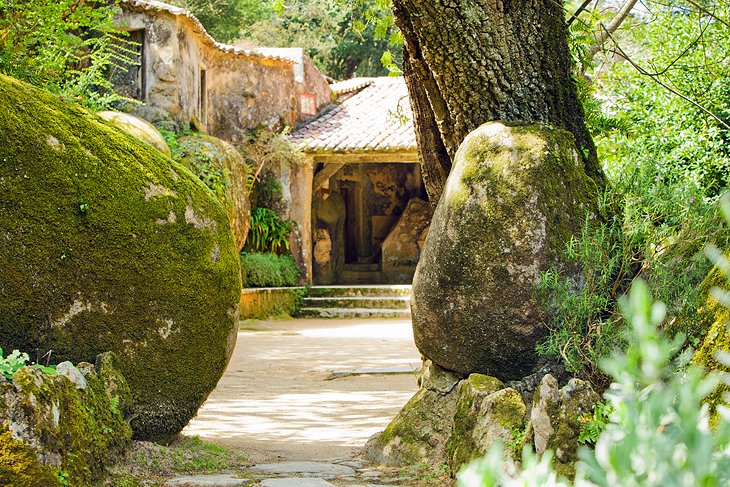
Arguably the most evocative of Sintra's historic attractions, the convent of Capuchos is certainly the most isolated. This remote Franciscan monastery is sunk into a ridge deep in the heart of the Serra de Sintra hills and is unique in Portugal for having most of its doors and rooms clad entirely in cork.
Founded in 1560, the retreat is little more than a collection of tiny rock-hewn cells where the resident monks lived. The cork, stripped from the surrounding woods, was used extensively throughout the hermitage and provided natural insulation against the sometimes harsh outdoor elements. The monastery was occupied for 300 years before being abandoned in 1834.
Along with cells, visitors are able to explore a small chapel, the washrooms, a kitchen, and refectory. Nature has reclaimed most of the complex - encroaching vines smother roofs, and moss blankets most of the stonework.
One can't help but be moved by this austere, rocky hideaway and the simple lifestyle adopted by the monks, a feeling made all the more acute by the absolute silence that shrouds the hermitage.
Location: 10 kilometers southwest of Sintra on the EN247-3
Palácio de Seteais

If there's one place in Sintra that captures the romance and serenity of the location, it's Seteais Palace. Built in the late 18th century for a Dutch diplomat, this elegant and stately manor is now an upscale boutique hotel, but the ground floor is accessible to non-residents.
Sitting in expansive, well-manicured grounds just a few minutes' walk from Quinta da Regaleira, the property is distinguished by an impressive monumental arch under which visitors can walk to reach the promenade where uninterrupted views of the Atlantic coastline can be admired.
Inside, ask the concierge to show you the beautiful Sala Gildemeester. Replete with original furnishings and illuminated by chandeliers, the walls and ceilings are decorated with rare frescoes attributed to French painter, Jean-Baptiste Pillement, and feature exotic flora and fauna. Non-residents can mingle with guests on the garden terrace, and pausing for tea or coffee is a particularly enchanting way to pass the afternoon.
Location: Rua Barbosa du Bocage 8, Sintra
Frequently Asked Questions
How do you get from Lisbon to Sintra?
The quickest and most convenient way to reach Sintra from Lisbon is by train. CP trains operates a regular service out of the city's Rossio station, about every half hour or so. The journey takes roughly 40 minutes.
Driving to Sintra is another option, but not recommended. The town is 25 kilometers northwest of Lisbon on the A16 highway, a nominal 30-minute drive. However, traffic is often heavy, and parking in Sintra is notoriously difficult, especially in the busy summer months.
There is no direct bus service from Sintra to Lisbon. But there is regular public transport between Sintra and Cascais on Urban Scotturb buses, which depart on an hourly basis. The journey takes around 45 minutes.
An alternative way to reach Sintra is to travel as part of a guided sightseeing tour.
What are the best beaches near Sintra?
Praia Grande: Translating as "Big Beach," this is the closest and certainly the most easily accessed beach from Sintra, and the best on the Sintra-Cascais coast in terms of facilities: there are plenty of shops, restaurants, and cafés spread along the generous swathe of sand.
While a summer draw for locals and tourists alike, Praia Grande is a year-round surfing destination, and has hosted several world championship surf tournaments. Interestingly, the cliffs at the southern end of Praia Grande are imprinted with a set of dinosaur footprints, estimated to be over 100 million years old.
Praia das Maçãs: Praia das Maçãs is a lively little resort and very popular in summer, frequented as it is by families and those who have holiday homes in the area.
According to local lore, this beach is named after the apples (maçãs) that would wash up on its sands after being carried down to the coast by the Ribeira de Colares stream.
Praia da Adraga: Scenic Praia da Adraga is not much more than a sandy cove. Reached via a deep, narrow valley and hemmed in by cliffs sculpted out by the sea, the beach here is quieter and mostly the preserve of locals, at least during the off-season period. It does get busier in summer, but not to the detriment of Adraga's wilder and more secluded nature.
Praia do Magoito: This is a beach to explore rather than lounge around on all day. The golden carpet of sand is studded with numerous rocks, many of which collect pools of crystalline water at low tide - great fun to discover with the kids on a lazy afternoon!
Praia da Ursa: Located just north of Cabo da Roca, this is arguably the most picturesque of Sintra's beaches.
A hidden gem of a destination, and sited well off the beaten track, Praia da Ursa is named for the "Rocha da Ursa" (bear rock) - one of two imposing sea stacks distinguishing the northern end of the beach.
Visitors need to follow a steep and winding trail to access Praia da Ursa, which doesn't make it a practical option for the less nimble beachgoer.
What are the must-see destinations near Sintra?
From Sintra, Lisbon is only a 30- to 40-minute drive away, with its astonishing Museu Nacional do Azulejo-Convento da Madre de Deus, the National Tile Museum. And don't forget to saunter through Lisbon's Old Quarter with its collection of churches, monuments, and museums.
The cosmopolitan resort town of Cascais serves as a convenient gateway to Sintra but warrants a few hours of anyone's itinerary for its captivating charm and seaside vibe.
The region's stunning palaces number among some of the most appealing in Portugal, and the Mosteiro Palácio Nacional de Mafra, located north of Sintra at Mafra, is the finest example of 18th-century Baroque architecture in the country.
Farther north on the coast is the fishing village of Ericeira. The unspoiled old town, with its maze of whitewashed cottages and narrow, cobbled lanes, is worth exploring at leisure. These days, however, the destination is better known for its big-name surfing competitions.

